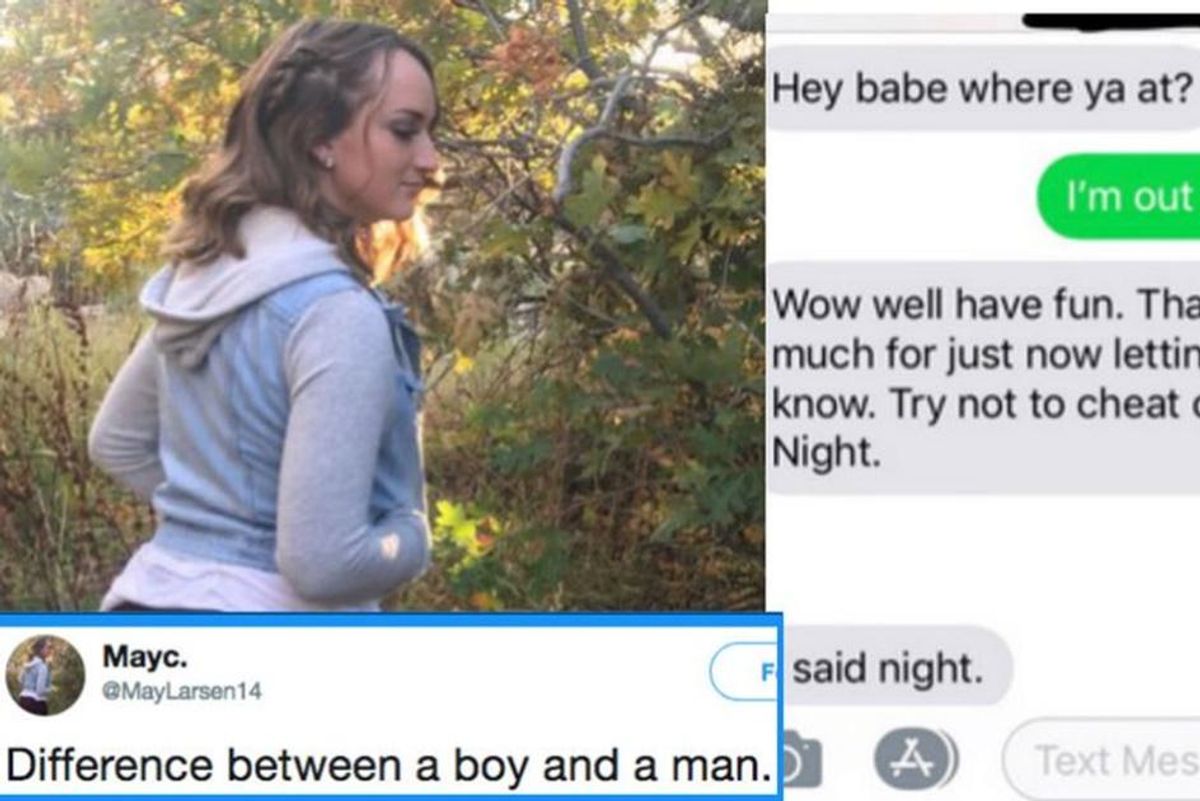Woman shares texts showing the difference between a healthy and a controlling relationship
Is it a healthy or controlling relationship?

The texting experience between two different men.
Saving old text messages from exes can sometimes be an asset when you need to remember exactly why you left them. Alternately, sometimes digital relics from old relationships serve as a good reminder of how much good we have in our lives currently.
At least, they did for the X user May Larsen, who posted screenshots of two text threads with two very different men in 2018.
The conversation on the left shows how an old conversation went down with an emotionally manipulative ex. While the other screenshot is a prime example of what communication in a healthy partnership looks like.
\u201cDifference between a boy and a man.\u201d— Mayc (@Mayc) 1533704969
The emotional dynamics of this exchange are full of red flags.

The unhealthy "Don’t cheat" Text.
Pic cropped from Twitter post.
This ex (boyfriend, hookup, whatever he was) went from 0-100 in no time. In fact, the ONLY way this kind of freak out would be excusable would be if they had prior plans she ditched on. Alternately, if he was doing a performance art bit where he embodied Drake's "0-100 / The Catch Up" via text message. Outside of those possibilities, this type of reaction is nothing short of manipulation and emotional abuse.
The second text message showed how Larsen's current partner responds to a simple night out:

The healthy "Let me know when you’re home safe" Text.
Pic cropped from Twitter post.
The difference between these responses to a simple night out on the town is night and day. When comparing the two messages, the red flags really pop.
People on X had a LOT of thoughts about the texts.
You\u2019re reminding the one on the left not to cheat. He already has his guard up. The one on the right is just doing the minimum— X \u00c6 A-12 Musk (@X \u00c6 A-12 Musk) 1533905239
A lot of people assumed the texts were from two guys she's currently dating.
SO IS EVERYONE IGNORING SHAWTY TALKING TO TWO GUYS AT THE SAME TIME?????— Not Josh (@Not Josh) 1533864031
Nah dude check the first one she cropped the time and allat out of it. You was right at first— Dee (@Dee) 1533873487
That quickly got shut down.
Don\u2019t get pressed over a joke B.— Dee (@Dee) 1533877627
Meanwhile, others were caught up with the fact that her current dude wears a cowboy hat.
You can tell which one is the man by the cool hat.— Adam Dane (@Adam Dane) 1533867124
YEEHAWW— \u2764\ufe0f\ud83e\udd0d\ud83d\udc7c \u0142\u2c64\u0142\u0246\u20ae\u2c64\u0142\u2c60\u2c60\u0142\u0246 (@\u2764\ufe0f\ud83e\udd0d\ud83d\udc7c \u0142\u2c64\u0142\u0246\u20ae\u2c64\u0142\u2c60\u2c60\u0142\u0246) 1533883789
Regardless of whether the rest of us are pro cowboy hat (I'm pro if you can pull it off), it seems they've got a healthy situation going. Communication is key, in any kind of relationship.
Update: It looks like May and Cowboy Hat got married in 2020. We love a happy ending!
- 6 songs that seem romantic but aren't, and one that seems like it isn't ... ›
- Incredibly moving last messages from loved ones. - Upworthy ›
- Have you been seeing a lot of red flag emojis on social media? Here's why. ›
- The 'No test' helps identify domestic abusers - Upworthy ›
- Therapist explains the difference between control and boundaries - Upworthy ›
- Woman is confused about husband's relationship with babysitter - Upworthy ›
- Gen Z sees periods in texts as aggressive. Nope. They're not. - Upworthy ›

